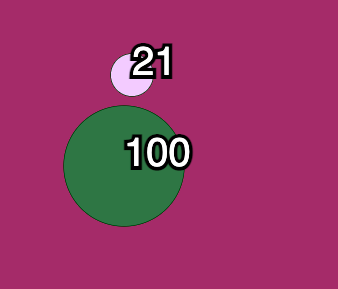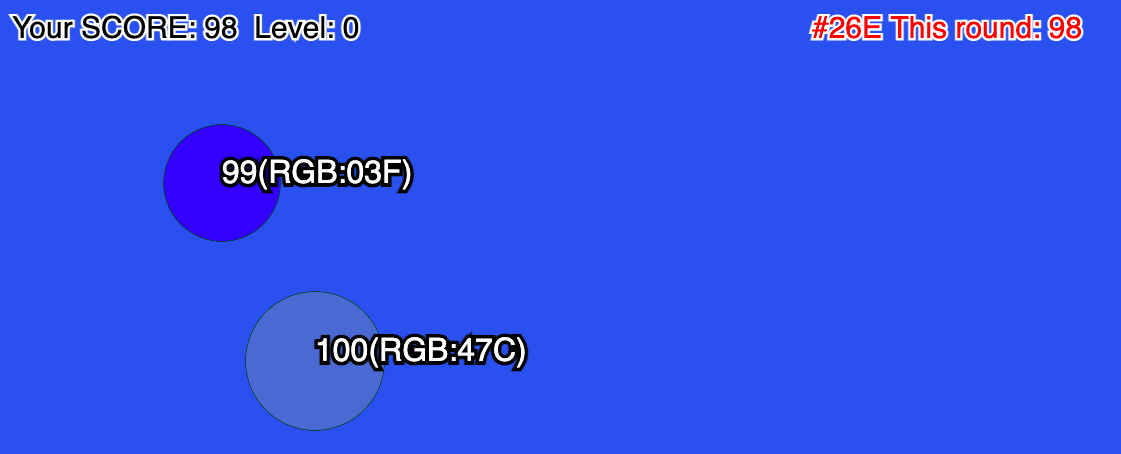YOUR GOAL
Click the circle with the closest color to the background
The color is only revealed when you hover over each circle
CAREFUL:
If the background color is, for instance, a dark green and you see a very
bright green circle, that might
not give you the best score - you might be better off clicking on a darker circle that doesn't
match the color as well.
In this example, the smaller circle is closer in color, but way too
bright - the dark green is the best score (SEE FULLER EXPLANATION AFTER THE
SCORING SECTION)

ENDGAME:
The game is over if you choose a circle whose score is less than 30, but at
the beginning of each new level (1, 10, 20), you cannot die in the the first 3 rounds of any new
level
RGB:
The colors are based on the RGB color model (see
explanation related to my other RGB game)
In the first few rounds, you can see
these
color values at the end of the round - but you'll only see the 1st digit for each color
(being off by just 1 in that
digit makes a difference of 16)
This might help you do quick subtraction to see why some
scores are better than others
IMPORTANT:
100 is the highest score, but that doesn't mean the color of that circle is
super close to the
background color!
It does means that the circle you clicked has the color that, of all the circles
on
the screen, is the closest to the background color
POWERUPS:
There are powerups that kick in after level 6. If you get a very high scoring circle
after that round, you will get a popup telling you about it
(you cannot get powerups when the
total number of cirles is low - but you also can't die!)
SPECIAL FEATURES:
• Between levels 15 and 20 and after level 25, when you hover over a circle, it will freeze while
you are over it
• If you lose, you'll have a "Last Chance" - but you HAVE TO get the best circle on the screen to
survive
(the number of cicles in this "last chance" round will increase each time you go through it)
SCORING:
The score is based on finding the difference in each of the R, G, and B values, then turning
those differences
into a number from 1 to 100. If you find the explanation below confusing, at least just look at
the image and
explanation at the end...
raw_score = 765 - |r1 - r2| + |g1 - g2| + |b1 - b2|
(765 is 255 + 255 + 255)
Example: if you're only off by 1 (!) in each R, G, and B, you get:
r_s = 765 - 1 - 1 - 1 = 762
(the highest you can get is 765)
Example: if your RGB is off by 63, 10, and 20 you get:
r_s = 765 - 95 = 670
Next I find the "best possible score":
best_possible_score = highest of all the raw_scores of the all the circles
Example: with 4 circles:
raw_scores: 502, 123, 670, 402
best_possible_score: 670
CALCULATING THE ACTUAL SCORE:
actual_score = 100(raw_score / best_possible_score)
(but rounded)
This means that every score is between 1 and 100
Examples:
Assume that the best_possible_score = 670
raw_score = 67 so 100(67 / 670) = 2 points
(rounded)
raw_score = 335 so 100(335 / 670) = 10 points
(1001/2 is the
square root
of
100!)
raw_score = 502 so 100(502 / 670) = 32 points
(rounded)
raw_score = 640 so 100(640 / 670) = 81 points
(rounded)
raw_score = 670 so 100(670 / 680) = 100
points
tldr; SCORING EXPLANATION:
Notice that in this scenario, which shows the first digit of each R, G, B for each circle and for
the background (shown in top right as #26E)...

...the "bluer" one is worth one less point!
This is because it's a little darker,
but
specifically because:
The RGB digits of the 99 is off by a total of 2 + 3 + 1 = 6 (see note 1)
The RGB digits of the 100 is off by t total of 2 + 1 + 2 = 5 (see note 2)
1(26E and 03F differ by 2, 3, and 1)
2(26E and 47C differ by 2, 1, and 2)
(CREDIT TO MARK KRANS FOR THE SCORING SYSTEM)
Coded by Anthony Beckwith 2022

